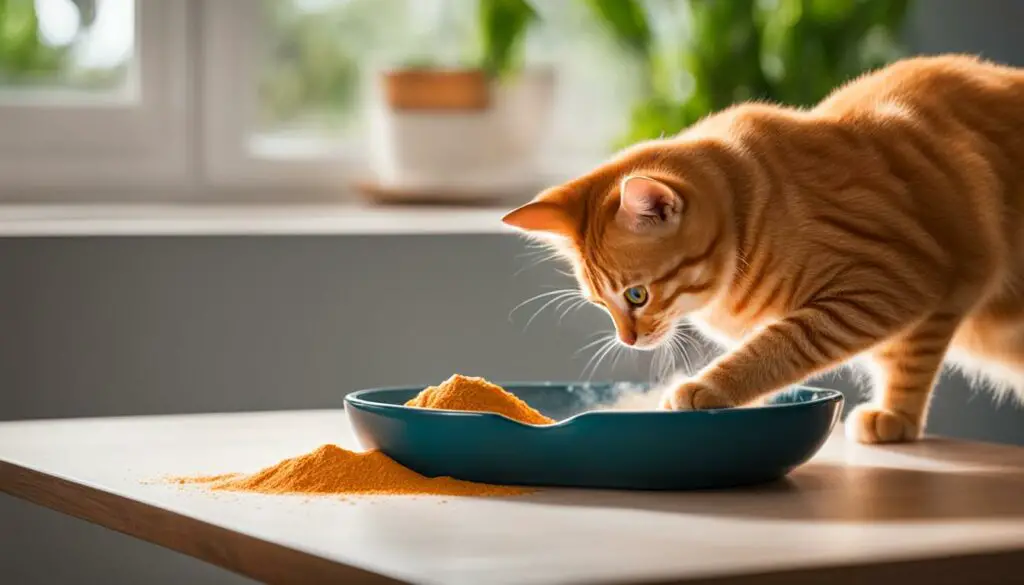As a cat owner, it can be concerning to see your furry friend experiencing constipation. Luckily, there are remedies available, and one popular option is Miralax. In this comprehensive guide, I will explore the effective use of Miralax for cats, providing you with all the information you need to know to help your feline companion find relief.
Key Takeaways:
- Miralax is a commonly used medication for treating constipation in cats.
- It works as a stool softener, helping to relieve constipation by drawing water into the intestines.
- Consult with a veterinarian to determine the proper dosage and administration for your cat.
- Monitor your cat for any potential side effects, such as diarrhea or dehydration.
- Address the underlying cause of constipation and follow your vet’s recommendations for optimal results.
Miralax for Cats Overview
Miralax is a commonly used osmotic laxative for cats, effective in treating constipation. It works by drawing water into the intestines, softening stools and promoting bowel movements. Sold in a tasteless powder form, Miralax is easy to administer to cats with constipation issues. However, it’s important to be aware of the proper dosage and potential side effects when using Miralax for cats.
How Miralax Works for Cats
Miralax contains polyethylene glycol 3350 (PEG 3350) as its active ingredient. When given to cats, Miralax helps to soften stools by drawing water into the intestines. This process helps to relieve constipation and promote regular bowel movements. Miralax is gentle on cats’ digestive systems and can be used as a short-term treatment for constipation caused by various factors such as changes in diet, kidney disease, fur ingestion, medications, or pain.
Proper Dosage and Administration
While there is no official dosage for Miralax in cats, it is important to consult with a veterinarian to determine the appropriate dosage for your cat. The dosage will depend on factors such as your cat’s age, health condition, and the severity of their constipation. As a general guideline, one-quarter teaspoon of Miralax can be administered once to twice daily per cat. However, it’s crucial to follow your vet’s advice to ensure the proper and safe use of Miralax.
Side Effects and Precautions
Although Miralax is generally safe for cats, there are potential side effects to be aware of. Common side effects may include diarrhea, flatulence, and sensitivity in cats with delicate stomachs. Additionally, Miralax can lead to dehydration in cats with underlying conditions or those who are already dehydrated. It is important to monitor your cat during treatment with Miralax and consult with your vet if any concerning side effects occur.
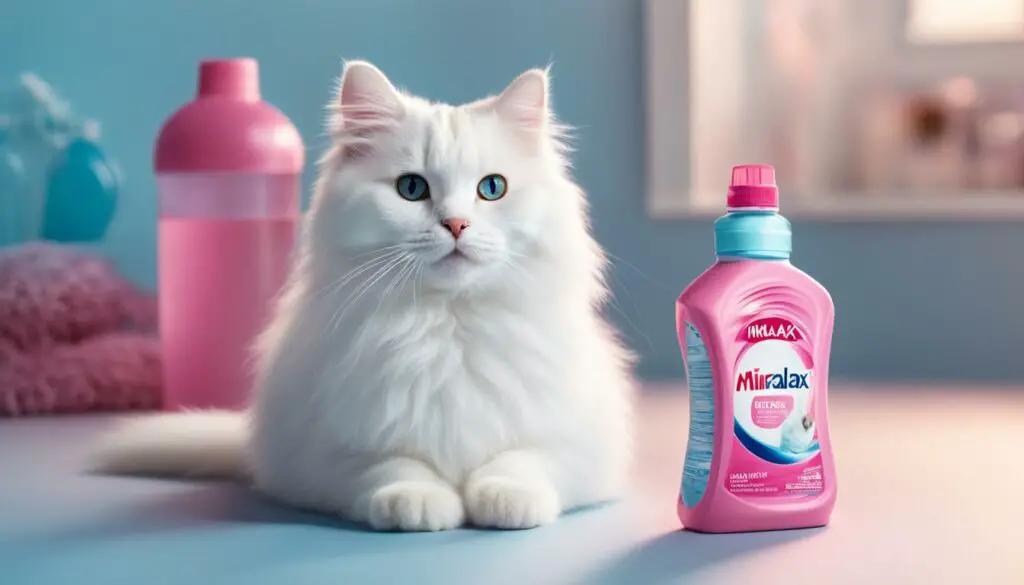
Using Miralax for cats can be an effective and safe option for treating constipation. However, it’s crucial to consult with a veterinarian for proper dosage, administration, and monitoring. Taking the necessary precautions will help ensure the well-being of your cat and alleviate constipation issues. By using Miralax under veterinary guidance, you can provide your cat with relief from constipation and promote their overall digestive health.
About Miralax for Cats
Miralax is a commonly used medication for the short-term treatment of constipation in cats. It contains the active ingredient polyethylene glycol 3350 (PEG 3350) and acts as a stool softener. Miralax can help relieve constipation in cats caused by various factors such as diet change, kidney disease, fur ingestion, medications, or pain. It is a gentle and easily administered treatment option that can be used to avoid more invasive procedures like enemas.
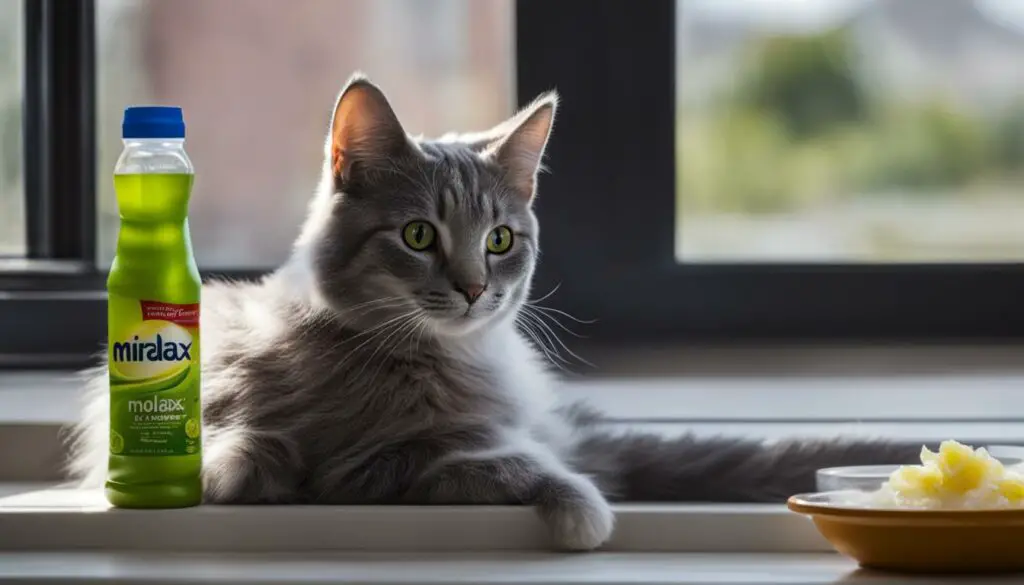
Miralax is considered safe for cats but should only be used under the guidance of a veterinarian. It is important to consult with your vet before starting any medication, as they can determine if Miralax is appropriate for your cat’s specific needs and condition. They will also be able to provide you with the correct dosage based on your cat’s age, weight, and the severity of their constipation.
When administering Miralax to your cat, it is typically mixed into their food. The powder is tasteless and can easily be disguised in wet food. It is important to ensure that your cat is well hydrated before giving Miralax and to provide them with ample water sources to prevent dehydration. Monitoring your cat’s response to the treatment is crucial; if any concerning side effects occur or if constipation persists, it is important to consult with your vet for further guidance.
Table: Miralax Dosage for Cats
| Cat Weight | Dosage |
|---|---|
| Under 5 lbs | 1/8 teaspoon once daily |
| 5-10 lbs | 1/4 teaspoon once daily |
| Over 10 lbs | 1/4 teaspoon twice daily |
It is important to follow the recommended dosage instructions provided by your veterinarian. Stick to the prescribed dosage and do not exceed it, as giving too much Miralax can lead to side effects such as diarrhea and gas. If you have any concerns or questions about the administration or dosage of Miralax for your cat, do not hesitate to reach out to your vet for clarification.
Miralax Dosage for Cats: What You Need to Know
When it comes to treating constipation in cats, Miralax can be a safe and effective option. However, since it is a human medication, there is no official Miralax dosage specifically for cats. It is crucial to consult with a veterinarian to determine the proper dosage for your feline friend. The veterinarian will take into account factors such as your cat’s age, overall health condition, and the severity of their constipation. Following their advice is essential because constipation can be a serious condition that requires professional guidance.
While there is no set dosage, a general guideline is to administer one-quarter teaspoon of Miralax once to twice daily per cat. However, it is crucial to remember that every cat is unique, and their dosage may vary. Your veterinarian will provide you with precise instructions based on your cat’s individual needs. It is always better to be safe and consult your veterinarian rather than administer a dosage without professional guidance.
In addition to determining the appropriate dosage, your veterinarian may also recommend monitoring your cat’s response to Miralax. This can help ensure that the treatment is effective and adjustments can be made if necessary. Regular communication with your veterinarian is essential throughout the treatment process, as they can provide guidance and support based on your cat’s specific requirements.
| Miralax Dosage for Cats | Instructions |
|---|---|
| Consultation with Veterinarian | Discuss your cat’s condition with a veterinarian to determine the appropriate Miralax dosage. |
| Individualized Dosage | Administer the specific dosage recommended by your veterinarian based on your cat’s age, health condition, and constipation severity. |
| Monitoring and Adjustments | Regularly monitor your cat’s response to Miralax and communicate any concerns or changes to your veterinarian for potential dosage adjustments. |
Remember, Miralax is just one part of a comprehensive treatment plan for constipation in cats. Your veterinarian may also recommend dietary changes, increased water intake, and other measures to address the underlying causes and promote overall digestive health. By working closely with your veterinarian, you can provide the best care for your cat and help them overcome constipation.
How to Administer Miralax to Cats
Administering Miralax to cats is a simple process that can help alleviate constipation and promote bowel regularity. Here are some steps to follow when giving your cat Miralax:
- Mix the recommended dose of Miralax into your cat’s favorite wet food.
- Thoroughly mix the Miralax into the wet food to disguise the powder and ensure even distribution.
- Offer the food to your cat, making sure they consume the entire dose of Miralax.
It is important to ensure that your cat is well hydrated before giving them Miralax. Providing plenty of water bowls and water fountains can help encourage your cat to drink and prevent dehydration. Additionally, it is recommended to monitor your cat’s response to Miralax treatment and consult with your veterinarian if constipation persists or worsens.
Precautions when administering Miralax
While Miralax is generally well-tolerated by cats, it is important to use caution and follow veterinary guidance. Here are some precautions to keep in mind:
- Do not exceed the recommended dosage of Miralax.
- Monitor your cat for any signs of dehydration or adverse reactions.
- If your cat has underlying health conditions or is on other medications, consult with your veterinarian before using Miralax.
Remember, Miralax is a human medication and should only be used under veterinary recommendation. By following these guidelines and working closely with your veterinarian, you can help ensure the safe and effective administration of Miralax to your cat.
| Advantages of administering Miralax to cats | Precautions when giving Miralax to cats |
|---|---|
| Miralax is tasteless and easily concealed in wet food | Do not exceed the recommended dosage |
| Can be administered at home without the need for invasive procedures | Monitor your cat for any signs of dehydration or adverse reactions |
| Can help alleviate constipation effectively | Consult with your veterinarian if your cat has underlying health conditions or is on other medications |
Miralax Side Effects in Cats
While Miralax is generally considered safe for cats, it is important to be aware of the potential side effects that may occur. Monitoring your cat closely can help detect any adverse reactions early on. The most common side effects of Miralax in cats include:
- Diarrhea
- Flatulence
- Sensitivity in cats with delicate stomachs
If you notice any of these side effects after administering Miralax to your cat, it is recommended to consult with your veterinarian. They can provide guidance and determine if any adjustments need to be made to the dosage or if an alternative treatment option is necessary.
Hairball-related Side Effects
In addition to its use as a constipation remedy, Miralax can also be helpful in cats with hairball issues. When cats groom themselves, they may ingest fur, which can lead to the formation of hairballs in the digestive tract. Miralax can assist in softening the stools and promoting the passage of hairballs. However, it is important to note that hairballs can still cause discomfort and even potential complications in cats, so regular grooming and preventive measures are recommended.
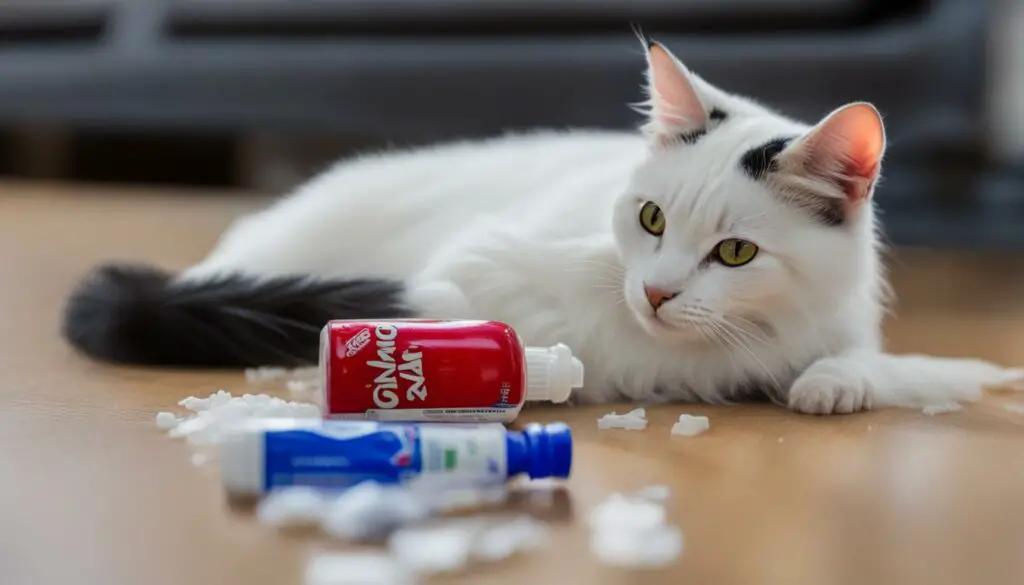
| Side Effect | Description |
|---|---|
| Diarrhea | Loose or watery stools, increased frequency of bowel movements. |
| Flatulence | Excessive gas in the gastrointestinal tract, leading to bloating and discomfort. |
| Sensitivity in cats with delicate stomachs | Cats with sensitive stomachs may experience digestive upset or an increase in vomiting. |
Using Miralax for cats with hairballs can be an effective solution, but it is important to address the underlying issue of excessive fur ingestion through regular grooming and other preventive measures. Consult with your veterinarian for guidance on managing hairball-related issues in your cat.
Miralax Overdose and Emergencies
Miralax is generally considered safe for cats when used as directed. However, it is important to use caution and be aware of the potential for overdose. Giving too much Miralax can lead to adverse effects such as diarrhea and gas. If you suspect that your cat has ingested an overdose of Miralax or if you have any concerns, it is crucial to contact your veterinarian or an emergency veterinary clinic immediately. They can provide guidance and assistance in case of an emergency.
It is important to note that Miralax is a human medication, and there is no official dosage for cats. The recommended dosage for cats should be determined by a veterinarian based on factors such as the cat’s age, health condition, and the severity of constipation. Following your veterinarian’s advice is essential as constipation can be a serious condition requiring proper treatment.
While overdoses of Miralax in cats are rare, it is always better to err on the side of caution and seek professional guidance. Prompt action can help ensure the well-being and safety of your cat. Remember, if you suspect an overdose or have any concerns, don’t hesitate to reach out to your veterinarian or an emergency veterinary clinic for immediate assistance.
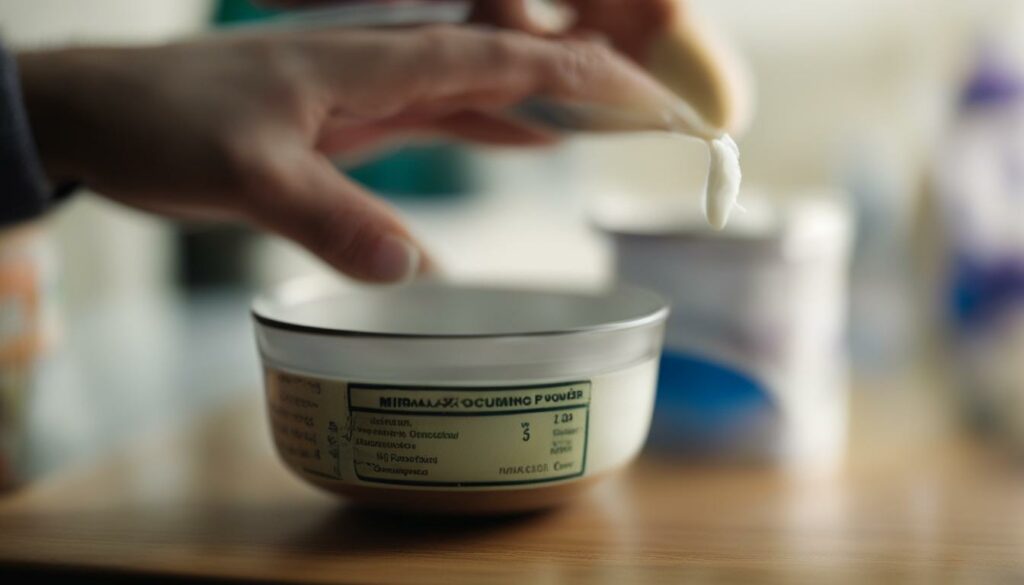
Table: Signs of Miralax Overdose in Cats
| Signs of Miralax Overdose in Cats | Action |
|---|---|
| Diarrhea | Contact your veterinarian for guidance. They may recommend adjusting the dosage or providing supportive care. |
| Gas | Monitor your cat closely and observe for any changes in behavior or discomfort. Contact your veterinarian if the gas persists or worsens. |
“If you suspect that your cat has ingested an overdose of Miralax or if you have any concerns, it is crucial to contact your veterinarian or an emergency veterinary clinic immediately.”
Potential Drug Interactions With Miralax
Miralax is generally considered safe to use and has fewer reported drug interactions compared to other laxatives. However, it is always important to discuss the use of Miralax with your veterinarian, especially if your cat has any underlying health conditions or is on other medications. Your vet will assess your cat’s individual case and determine if Miralax is appropriate and if there are any potential interactions with other medications.
While Miralax is generally well-tolerated, it’s important to be mindful of any potential drug interactions. Some medications may interact with Miralax, altering their effectiveness or causing adverse effects. It’s crucial to inform your veterinarian about all medications your cat is currently taking, including prescription medications, over-the-counter drugs, supplements, and herbal remedies.
One potential drug interaction to be aware of is the use of Miralax with other laxatives. Combining laxatives can increase the risk of diarrhea and dehydration in cats, so it’s important to use Miralax as directed by your veterinarian and avoid using other laxatives without their guidance.
Table: Potential Drug Interactions with Miralax
| Medication | Potential Interaction |
|---|---|
| Anti-seizure medications (e.g., phenobarbital) | Miralax may decrease the effectiveness of anti-seizure medications. |
| Antibiotics (e.g., metronidazole) | Miralax may interfere with the absorption of certain antibiotics. |
| Anticoagulant medications (e.g., warfarin) | Miralax may increase the risk of bleeding in cats taking anticoagulant medications. |
| Diuretics (e.g., furosemide) | Miralax may enhance the effects of diuretics, increasing the risk of dehydration. |
It’s important to note that this table is not exhaustive and there may be other potential drug interactions to consider. Always consult your veterinarian before starting any new medications or changing your cat’s treatment plan to ensure their safety and well-being.
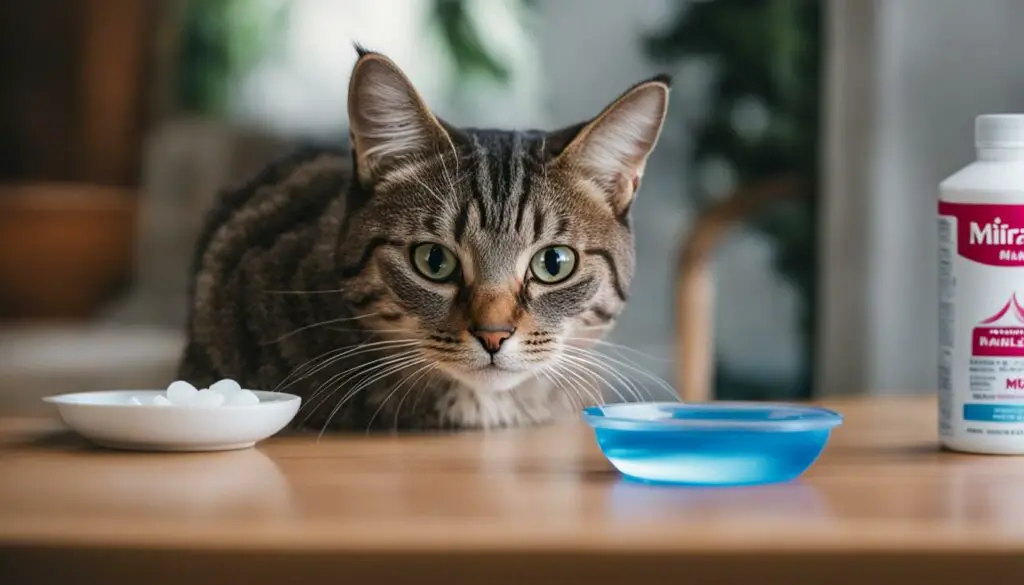
How to Store Miralax
Proper storage of Miralax is important to maintain its effectiveness and ensure its safety for your cat. By following a few simple guidelines, you can ensure that your supply of Miralax remains in good condition:
- Store Miralax in a child-proof container: It’s crucial to keep Miralax out of reach of children to prevent accidental ingestion.
- Avoid extreme temperatures: Miralax should be stored away from heat, moisture, sunlight, and cold temperatures. Avoid freezing Miralax, as it can impact its effectiveness.
- Check the expiry date: Do not use Miralax that has passed its expiry date. Expired medication may not be as effective and can potentially cause harm.
Proper storage of Miralax will help maintain its potency and ensure that it is available when you need it. By keeping it in a safe place and following the recommended storage guidelines, you can ensure that your cat’s Miralax treatment remains effective.

Table: Proper Storage Guidelines for Miralax
| Storage Tips | Guidelines |
|---|---|
| Container | Store Miralax in a child-proof container |
| Temperature | Avoid extreme heat, moisture, sunlight, and cold temperatures |
| Freezing | Do not freeze Miralax |
| Expiry Date | Do not use Miralax that is past its expiry date |
By adhering to these storage guidelines, you can ensure that your Miralax remains safe and effective for use in treating your cat’s constipation.
Miralax for Cats: Final Thoughts
After exploring the effectiveness and proper use of Miralax for cats, it is clear that this human medication can be a valuable tool in treating constipation in our feline friends. Under the guidance of a veterinarian, Miralax can provide relief and promote healthy bowel movements. However, it’s important to remember that Miralax is a human medication and should only be used under veterinary recommendation.
When administering Miralax to your cat, it is essential to closely monitor their response and be aware of potential side effects. While Miralax is generally well-tolerated, some cats may experience diarrhea, flatulence, or sensitivity, especially if they have underlying health conditions or sensitive stomachs. If any concerning side effects occur, it is crucial to consult with your veterinarian for further guidance.
It’s also worth noting that treating constipation in cats requires a comprehensive approach that addresses the underlying cause. Miralax can provide short-term relief, but it’s essential to identify and address any dietary, lifestyle, or medical factors contributing to the constipation. Working closely with your veterinarian will ensure the best outcome for your cat’s digestive health.
Overall, Miralax can be a safe and effective option for managing constipation in cats. However, it should always be used under veterinary supervision, and any concerns or questions should be discussed with your veterinarian. With the right care and attention, Miralax can help your cat find relief and maintain healthy bowel movements.
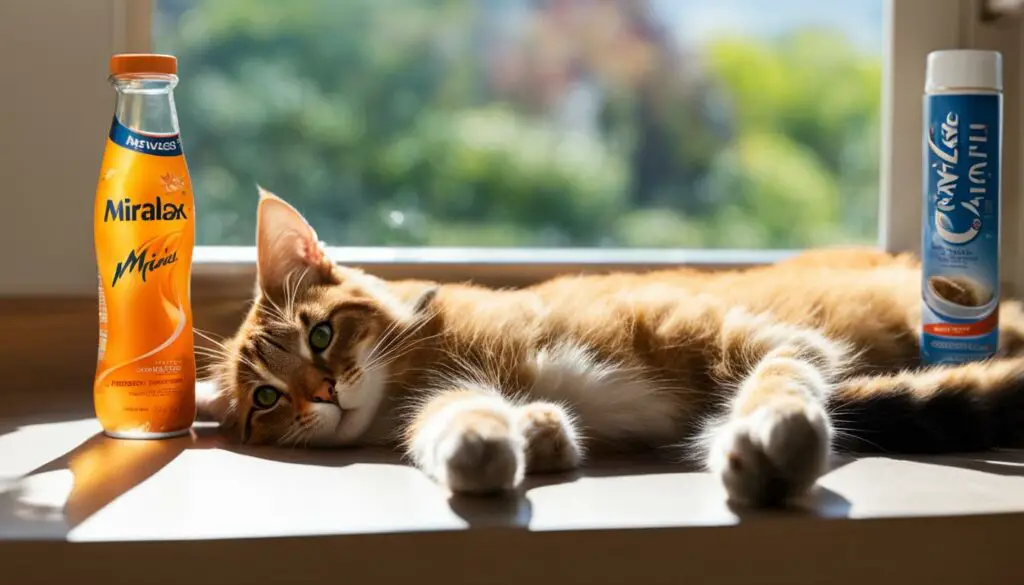
References
- Reference 1
- Reference 2
- Reference 3
How Often Do Cats Poop?
Cats typically poop once a day, on average. However, the frequency of bowel movements can vary depending on various factors such as age, diet, and individual differences. It is important to keep in mind that healthy variation is normal. Monitoring your cat’s bowel movements can provide insights into their digestive health, but it is essential to understand that there is no one-size-fits-all answer.
Changes in your cat’s frequency of bowel movements or signs of constipation should be closely observed. If you notice any abnormalities, it is crucial to consult with a veterinarian for proper assessment and treatment. They will be able to provide guidance on what is considered normal for your cat based on their specific needs and circumstances.
As a responsible cat owner, understanding your cat’s bathroom habits can help you detect potential problems early on and take appropriate action. Regular veterinary check-ups and maintaining a balanced diet are essential in promoting healthy digestion and preventing constipation in cats.
Table:
| Factors | Influence on Frequency |
|---|---|
| Age | Newborn kittens may poop several times a day, while older cats tend to have fewer bowel movements. |
| Diet | High-fiber diets can result in more frequent bowel movements, while low-fiber diets may lead to less frequent ones. |
| Individual Differences | Just like humans, each cat has their own unique metabolism and digestive system, which can affect the regularity of their bowel movements. |
By understanding the factors that influence your cat’s bathroom habits, you can better assess what is normal for them. If you have any concerns or notice any changes in your cat’s bathroom routine, it is always best to consult with a veterinarian for professional advice.

Signs of Constipation in Cats
If you suspect that your cat is constipated, it’s important to be able to recognize the signs. Constipation can be uncomfortable and even dangerous for cats if left untreated. Here are some common signs to watch out for:
- Frequent unsuccessful trips to the litter box
- Loss of appetite
- Vomiting
- Weight loss
- Lack of energy
- Poor coat condition
These signs may indicate that your cat is experiencing constipation and is in need of relief. It’s important to take action and seek veterinary care if you notice these symptoms in your cat.
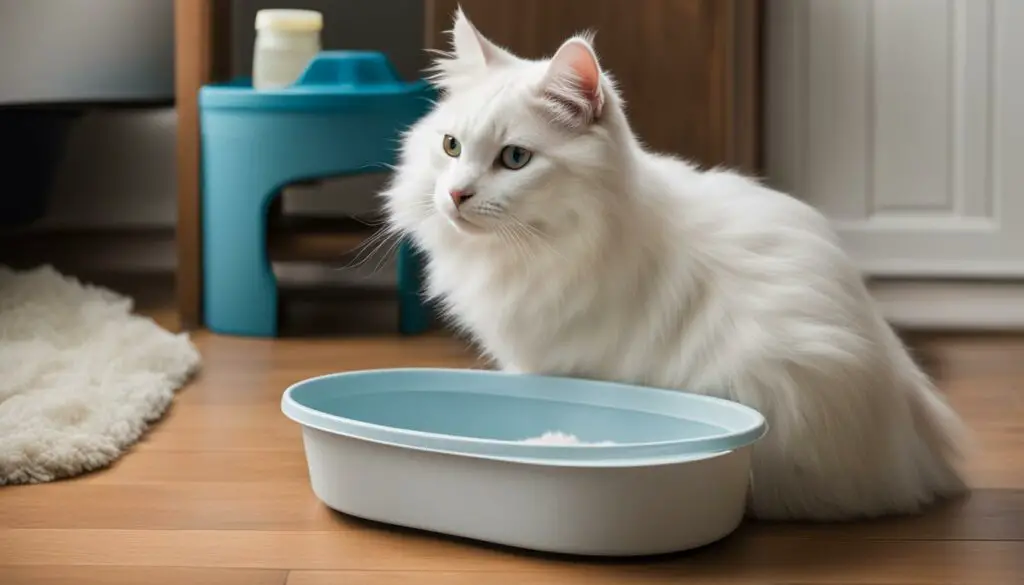
Cat Constipation Remedies
If your cat is suffering from constipation, there are several remedies that can help alleviate this uncomfortable condition. Alongside Miralax, which we have discussed in detail in previous sections, these remedies can provide relief and help improve your cat’s digestive health. It’s important to note that while these remedies can be effective, it’s always best to consult with your veterinarian to ensure the proper treatment for your cat’s individual needs.
Increase Water Intake
Hydration plays a crucial role in maintaining healthy bowel movements. Encourage your cat to drink more water by providing multiple water bowls or using a water fountain. Some cats prefer running water, so a fountain can be particularly enticing. Wet food can also contribute to your cat’s hydration, as it has a higher water content compared to dry kibble.
Add Fiber to the Diet
Fiber can help regulate bowel movements by adding bulk and softening the stool. You can incorporate fiber into your cat’s diet by feeding them high-fiber cat food or adding fiber supplements recommended by your veterinarian. Some examples of high-fiber foods include pumpkin puree (without added sugar or spice) and psyllium husk.
Provide Regular Exercise and Grooming
Regular exercise can help stimulate the digestive system and promote regular bowel movements. Engage your cat in interactive play sessions and provide them with toys that encourage physical activity. Additionally, regular grooming can help prevent excessive fur ingestion, which can contribute to constipation. Brush your cat regularly to remove loose hair and reduce the chances of hairballs.
Remember, while these remedies can be beneficial, they may not be suitable for all cats. It’s important to consult with your veterinarian to determine the best course of action for your cat’s constipation. They will be able to provide personalized recommendations based on your cat’s individual needs and underlying health conditions.
Table 13.1: Pros and Cons of Cat Constipation Remedies
| Remedy | Pros | Cons |
|---|---|---|
| Increase Water Intake |
|
|
| Add Fiber to the Diet |
|
|
| Regular Exercise and Grooming |
|
|

How Long Can Cats Take Miralax?
Miralax is typically used for the short-term treatment of constipation in cats. The duration of treatment can vary depending on the severity of the constipation and the response to Miralax. It may be used for a few days to a few weeks, as recommended by your veterinarian. If constipation persists or recurs, further evaluation may be needed to address the underlying cause.
Recommended Treatment Duration
The length of time cats can take Miralax depends on their individual response to the medication. Typically, Miralax is used for a short period to alleviate constipation and promote regular bowel movements. Your veterinarian will determine the appropriate duration based on your cat’s specific condition and response to treatment.
Monitoring and Consultation
While Miralax can be effective in treating constipation, it is important to monitor your cat’s progress closely. If constipation persists or worsens despite using Miralax, it is recommended to consult with your veterinarian. They can assess your cat’s condition and determine if additional interventions or a different treatment approach is necessary.
Regular follow-up appointments with your veterinarian are crucial to evaluate the effectiveness of Miralax and make any necessary adjustments to the treatment plan. Your vet will guide you on the appropriate duration of Miralax usage for your cat’s specific needs, ensuring a safe and effective treatment course.
“Miralax is typically used for a short period to alleviate constipation and promote regular bowel movements.”
| Pros of Miralax Usage | Cons of Miralax Usage |
|---|---|
|
|
How Long Does It Take Miralax to Work in Cats?
When it comes to treating constipation in cats, time is of the essence. As a cat owner, you want to ensure that your feline friend receives relief as quickly as possible. So, how long does it take for Miralax, a commonly used cat constipation remedy, to work?
According to veterinary experts, Miralax typically starts working within eight to twelve hours in cats. This means that after administering the medication, you can expect your cat to produce feces within 24 hours. However, it’s important to note that individual response times may vary. Some cats may respond more quickly, while others may take a bit longer to experience the desired effects.
It’s crucial to closely monitor your cat’s response to Miralax. If constipation persists or worsens after starting the treatment, it’s recommended to consult with your veterinarian. They can provide further guidance and determine if additional interventions are necessary.
How to Monitor Your Cat’s Response
When monitoring your cat’s response to Miralax, there are a few factors to consider. You’ll want to observe their bowel movements, looking for signs of improvement such as increased frequency and ease of passing stool. It’s also essential to keep an eye out for any concerning symptoms or side effects.
If you notice that your cat is still struggling with constipation or experiencing any adverse reactions, it’s important to reach out to your veterinarian. They can help assess the situation, adjust the treatment plan if needed, and address any underlying causes of the constipation.
| Signs Miralax is Working in Cats | Signs of Potential Side Effects or Lack of Response |
|---|---|
| Frequent, easier bowel movements | Continued straining or difficulty passing stool |
| Increase in stool volume | Loss of appetite |
| Less time spent in the litter box | Vomiting |
| Improved overall energy and well-being | Weight loss |
| Poor coat condition |
Remember, the effectiveness of Miralax in treating cat constipation depends on various factors, including the severity of the condition and the cat’s overall health. Consulting with a veterinarian is crucial for proper diagnosis, determining the appropriate dosage, and monitoring your cat’s progress.
Conclusion
In conclusion, Miralax can be a reliable and effective remedy for cat constipation, with many positive reviews from cat owners. Under the guidance of a veterinarian, Miralax can help soften stools, relieve constipation, and improve your cat’s overall digestive health.
When using Miralax, it is crucial to follow the recommended dosage and closely monitor your cat for any side effects. Additionally, addressing the underlying cause of constipation, such as diet changes or fur ingestion, can help prevent future episodes.
Remember, the duration of Miralax treatment may vary depending on the severity of constipation and your cat’s response. If constipation persists or worsens, it is important to consult with your veterinarian for further evaluation and guidance.
In summary, Miralax is a trusted cat constipation remedy that can provide relief and improve your cat’s well-being. By working closely with your veterinarian and following their advice, you can ensure the best outcome for your cat’s digestive health.
FAQ
What is Miralax and how does it work for cats?
Miralax is a human medication used for the treatment of constipation in cats. It works by drawing water into the intestines, softening stools, and treating constipation.
What are the common side effects of Miralax in cats?
Common side effects of Miralax in cats may include diarrhea, flatulence, and dehydration.
How do I determine the proper dosage of Miralax for my cat?
It is recommended to consult with a veterinarian to determine the proper dosage based on your cat’s age, health condition, and the severity of their constipation.
How do I administer Miralax to my cat?
Miralax is a tasteless powder that can be mixed into your cat’s wet food. It is important to thoroughly mix it to disguise the powder.
Are there any potential side effects of Miralax in cats?
Yes, common side effects may include diarrhea, flatulence, and sensitivity in cats with delicate stomachs.
What should I do if I suspect an overdose of Miralax in my cat?
If you suspect an overdose, contact your veterinarian or an emergency veterinary clinic immediately for guidance and assistance.
Are there any potential drug interactions with Miralax in cats?
Miralax has fewer reported drug interactions compared to other laxatives, but it is still important to discuss its use with your veterinarian if your cat is on other medications.
How should Miralax be stored?
Miralax should be stored in a child-proof container, away from extreme heat, moisture, sunlight, or cold temperatures. It should not be frozen.
Can cats take Miralax long-term?
Miralax is typically used for the short-term treatment of constipation in cats. The duration of treatment can vary depending on the severity of the constipation and the response to Miralax.
How long does it take for Miralax to work in cats?
Miralax usually starts working within eight to twelve hours in cats. Feces should be produced within 24 hours of administering Miralax.

